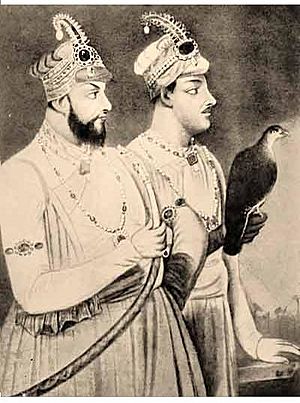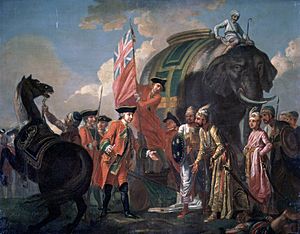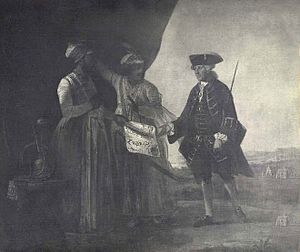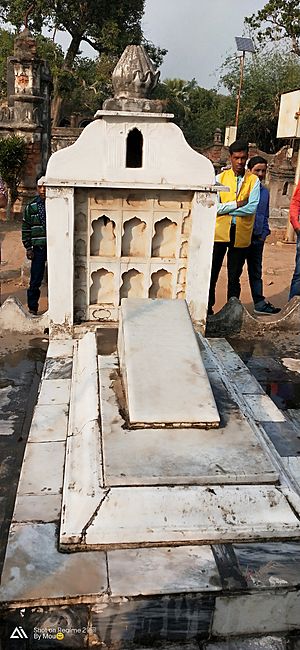Mir Jafar facts for kids
Quick facts for kids Syed Mir Jafar Ali Khan Bahadur |
|||||
|---|---|---|---|---|---|

Mir Jafar (left) and his eldest son, Mir Miran (right).
|
|||||
| Nawab Nazim of Bengal and Bihar | |||||
| 1st reign | 2 July 1757 – 20 October 1760 | ||||
| Predecessor | Siraj ud-Daulah | ||||
| Successor | Mir Qasim | ||||
| 2nd reign | 25 July 1763 – 5 February 1765 | ||||
| Predecessor | Mir Qasim | ||||
| Successor | Najimuddin Ali Khan | ||||
| Born | 1691 Delhi, Mughal Empire |
||||
| Died | 5 February 1765 (aged 73–74) Bengal Subah |
||||
| Burial | Jafarganj Cemetery, Murshidabad | ||||
| Spouse | Shah Khanum (m. 1727, d. August 1779) Munni Begum (m. 1746, d. 10 January 1813) Rahat-un-nisa Begum (Mut'ah wife) Babbu Begum (d. 1809) |
||||
| Issue |
|
||||
|
|||||
| House | Najafi | ||||
| Father | Saiyed Ahmed Najafi (Mirza Mirak) | ||||
| Religion | Shia Islam | ||||
Sayyid Mir Jafar Ali Khan Bahadur (around 1691 – 5 February 1765) was a military leader. He became the first ruler of Bengal who depended on the British East India Company. Many historians believe his rule marked the start of British control over the Indian subcontinent. This was a big step towards Britain taking over large parts of what is now India, Pakistan, and Bangladesh.
Mir Jafar was the commander of the Bengal army under Siraj ud-Daulah, who was the Nawab (ruler) of Bengal. But Mir Jafar secretly worked against him during the Battle of Plassey in 1757. After the British won, Mir Jafar became the new Nawab. The East India Company supported him with their army until 1760. However, Mir Jafar could not meet all the British demands. In 1758, Robert Clive found out that Mir Jafar had made a secret deal with the Dutch East India Company. This led to a fight between Mir Jafar and the British.
In October 1760, the British forced Mir Jafar to give up his position. His son-in-law, Mir Qasim, became the new Nawab. But the East India Company later removed Mir Qasim too, because they disagreed about trade. Mir Jafar was made Nawab again in 1763 with British help. Mir Qasim did not accept this and went to war against the Company. Mir Jafar ruled until he died on 5 February 1765. He is buried at the Jafarganj Cemetery in Murshidabad, West Bengal.
Because he helped the British take control of India, Mir Jafar is often seen as a traitor. This is especially true among people in India and Bangladesh. His name has become a symbol for betrayal in the region.
Contents
Early Life and Family History
Sayyid Mir Muhammad Jafar was born in Delhi in 1691. He was the second of seven sons. His family said they were descendants of Hasan ibn Hasan, an important historical figure. Mir Jafar's grandfather, Sayyid Husayn Tabatabaei, moved from Najaf in Iraq to Delhi in 1675. The Mughal emperor Aurangzeb invited him. Tabatabaei married the emperor's niece and worked as a judge in the Mughal court. Mir Jafar's aunt was married to Nawab Alivardi Khan of Bengal.
Serving the Nawab of Bengal
In 1747, a powerful group called the Maratha Empire started attacking and taking over lands belonging to Alivardi Khan, the Nawab of Bengal. During a Maratha attack on Odisha, Mir Jafar was a governor there. He pulled back all his soldiers. This happened until Alivardi Khan and the Mughal Army arrived. They completely defeated the Maratha forces at the Battle of Burdwan. Because Mir Jafar had failed, the angry Alivardi Khan removed him from his position.
Becoming Nawab of Bengal
Mir Jafar was the main general for Siraj ud-Daulah, who took over from Alivardi Khan. Siraj ud-Daulah's army won against the British on 19 June 1756. However, Siraj ud-Daulah started to favor another person, Raja Manikchand, instead of Mir Jafar. Mir Jafar was unhappy and found others who also disliked Siraj's cruel rule. These included his fellow generals and the very rich Jagat Seths.
These unhappy nobles decided to ask the British Company for help. The Company had become very strong in the region under Robert Clive. A Company official named William Watts found out about the nobles' plans. He learned that Mir Jafar, who managed the Bengal army's money, was ready to pay a huge amount of money (about £325 million today) if the Company helped remove the Nawab.
Robert Clive also thought Siraj was a bad ruler. So, Mir Jafar's army, the Jagat Seths' money, and Clive's soldiers got ready to take over the government.
Mir Jafar secretly worked against Siraj ud-Daulah during the Battle of Plassey. After Siraj ud-Daulah was defeated and killed, Mir Jafar became the Nawab. The East India Company put him in power, but he was like a "puppet" ruler, meaning the British controlled him. Mir Jafar paid the Company and city traders a lot of money (Rs. 17,700,000) for the attack on Calcutta. He also gave large bribes to Company officials, like over two million rupees to Robert Clive.
Soon, Mir Jafar realized the Company wanted more and more. He tried to get free from their control by asking the Dutch for help. But the British defeated the Dutch in the Battle of Chinsurah in November 1759. In return, the British forced Mir Jafar to give up his position. His son-in-law, Mir Qasim, became the new Nawab.
Mir Qasim was a strong and independent ruler. But he soon argued with the Company because they refused to pay taxes to him. Mir Qasim then formed an alliance to force the East India Company out of East India. The Company went to war against him and his allies. The Battle of Buxar was fought on 22 October 1764. The East India Company, led by Hector Munro, fought against the combined armies of Mir Qasim, the Nawab of Awadh, and the Mughal Emperor Shah Alam II.
Mir Qasim was defeated in Buxar and removed from power. Mir Jafar managed to get back on good terms with the British. He was made Nawab again in 1764 and stayed in that position until he died in 1765.
Bengal War and Mughal Empire
In 1760, the Mughal Prince Ali Gauhar and his army of 30,000 tried to overthrow Mir Jafar. They advanced towards Awadh and Patna. But the powerful East India Company soon got involved in this conflict. The Mughals were joined by other rulers and even some French soldiers. They fought against the British during the Seven Years' War.
Even though the French were defeated, the fight between the British East India Company and the Mughal Empire continued. It ended in a draw, which later led to the Battle of Buxar.
Mir Jafar's Legacy

By 1750, the large Mughal Empire had broken up into many smaller, independent kingdoms. These kingdoms often fought each other. They bought weapons from the British and French East India companies to help with their wars. Bengal was one of these kingdoms. The British and French supported whichever rulers helped their trading interests.
Mir Jafar became ruler with the help of the British East India Company. After the defeat of Siraj ud-Daulah and later Mir Qasim, the British became very strong in Bengal. In 1793, they took complete control of the former Mughal province.
Muhammad Iqbal, a famous poet from the Indian subcontinent, spoke strongly against Mir Jafar. He wrote:
"Jaffar az Bengal, o Sadiq az Deccan
Nang–e–Adam, Nang–e–Deen, Nange–Watan"
This means: "Mir Jaffar of Bengal and Mir Sadiq of Deccan, are a disgrace to mankind, and their religion and country!"
See also
- Namak Haram Deorhi
- Great Britain in the Seven Years War
- Mir Sadiq
- Iskander Mirza




